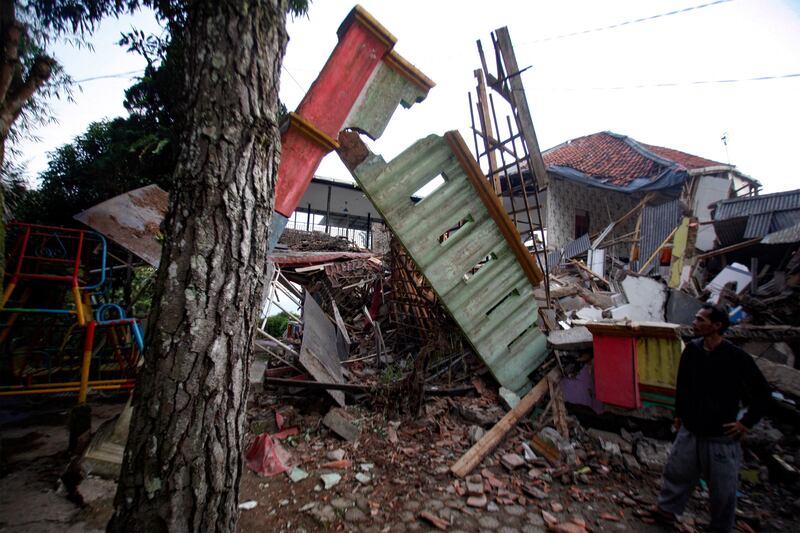A strong earthquake struck the main island of Indonesia on Monday, killing at least 162 people, injuring hundreds and shaking tall buildings in the capital, Jakarta, 60 miles away.
The magnitude-5.6 earthquake struck near the city of Cianjur, one of the most disaster-prone districts in Indonesia. It caused the collapse of hundreds of buildings as well as landslides that prevented many people from reaching the city’s main hospital.
The hospital itself was damaged and lost electrical power, said Herman Suherman, a government official in Cianjur.
“This is overwhelming,” he said, adding that the hospital was desperate for more doctors to treat the flood of injuries and for a restoration of power.
READ MORE
He said that many people, unable to reach the main hospital, were being treated wherever they were injured. The death toll rose significantly as new reports were tallied. As evening fell, Ridwan Kamil, West Java’s governor, said that 162 people had died.
The police in Cianjur said that the number of fatalities was likely to increase because so many people were trapped under the rubble of ruined buildings and landslides.
“So many buildings crumbled and shattered,” the governor said. “There are residents trapped in isolated places,” he said, “so we are under the assumption that the number of injured and deaths will rise with time.”

Survivors dug urgently into the night, sometimes using just their hands, to try to rescue victims trapped in the rubble. A television video showed rescuers unable to reach victims because of a lack of tools to dig and remove debris.
Emergency workers were treating the injured on stretchers outside the main hospitals and in parking lots and open spaces. Many, including children, were given oxygen masks and were receiving intravenous treatment.
The government erected tents outside the damaged hospital to shelter and treat those who were injured. Many arrived on the backs of motorbikes because ambulances and other vehicles could not navigate landslides that blocked some roads.
As more victims arrived, emergency workers were prioritising those who needed immediate treatment. Both the hospital and the surrounding tent areas were filled to capacity, the governor said.
Many of the victims were women and children because they were indoors while the men worked outside. Many family members were separated by the quake, he said.
Several of the injured complained of pain in their shoulders and ribs from being hit by falling debris.
In Jakarta, residents reported that buildings swayed and furniture was shaken, causing people to run into the streets for safety.
According to early reports from the Indonesian National Disaster Mitigation Agency, the earthquake destroyed 343 buildings and damaged many others, including some government offices, schools and religious houses.
The vast Indonesian archipelago, with its long coastline and many islands, lies on the “Ring of Fire,” an arc of volcanoes and fault lines along the Pacific Basin that is frequently hit by earthquakes and volcanic eruptions. Large and small earthquakes occur virtually every day.
Monday’s quake was the latest in a series of recent disasters. In February, a magnitude 6.2 earthquake killed at least 25 people and injured more that 450 others in West Sumatra province. In January 2021 a magnitude 6.2 earthquake killed more than 100 people and injured nearly 6,500 people in West Sulawesi province.
The Cianjur district is one of the most dangerous areas in Indonesia, suffering frequent floods, landslides and droughts as well as earthquakes, tsunamis and volcanic eruptions, according to the Indonesia Disaster Risk Index.
At least 57 people were killed by a 7.1 magnitude quake in Cianjur in September 2009.
In the most devastating disaster in recent years, an Indian Ocean earthquake off Sumatra island in northern Indonesia caused a tsunami in December 2004 that killed nearly 230,000 people, more than half of them in Indonesia.
In 1883 the Krakatoa volcano in the Sunda Strait was one of the deadliest and most destructive volcanic events in recorded history. The explosion was heard hundreds of miles away and a filter of ash coloured sunsets around the world. At least 36,000 deaths were attributed to the eruption and the tsunami that followed.
Since then a new volcano, known as “Baby Krakatoa,” has begun to rise in its place.
Death tolls continue to increase from such disasters as Indonesia’s population has risen rapidly to 270 million, as cities have expanded and people have made their homes in ever more precarious areas, said Kerry Sieh, an American seismologist who closely follows Indonesia. – This article originally appeared in The New York Times













